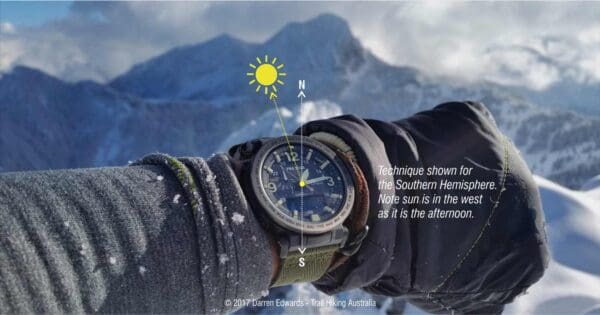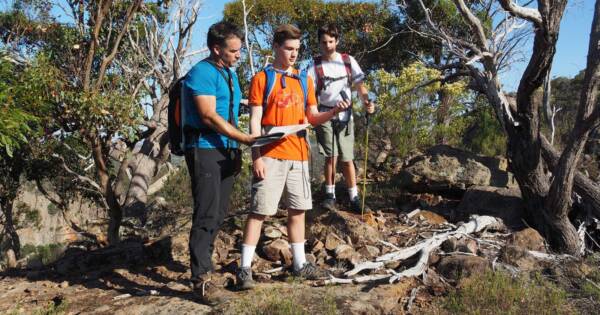Exploring the great outdoors on a hiking adventure can be an exhilarating experience. To make the most of your hikes, it’s essential to equip yourself with the right tools. One such tool that has gained popularity among hikers is the GPS watch. In this quick guide, I’ll explore some of the benefits of using a GPS watch for hiking, a few tips on optimal use, things to consider before purchasing, and a few GPS alternatives.
Here’s a few benefits of using a GPS watch for hiking
A GPS watch can enhance your hiking experience by providing valuable navigation, safety, and fitness-related information. However, it’s important to remember that a GPS watch should not be relied upon as the sole means of navigation. It’s always a good idea to carry a paper map, compass, and have a basic understanding of traditional navigation techniques when venturing into the wilderness.
Navigation made easier
GPS watches provide accurate location tracking, allowing you to see your current position on a map. This can help you navigate trails, especially in unfamiliar or complex terrains. You can also mark waypoints or set routes in advance, making it easier to follow a planned itinerary. The right GPS watch can provide accurate location tracking, mapping features and waypoints, and simplified trail navigation.
Distance and speed monitoring
GPS watches can track the distance you’ve covered during your hike, as well as your current speed. This information can be valuable for monitoring your progress, estimating the time to reach your destination, and gauging your overall fitness level.
Elevation and altitude data
Many GPS watches include altimeters, which can measure the altitude or elevation gain during your hike. This information can be helpful for tracking your ascent and descent, identifying steep sections, and estimating the difficulty of the trail.
Safety and emergency situations
GPS watches often have built-in features like SOS alerts, which can be vital in case of emergencies or getting lost. They can help rescuers locate you accurately and quickly. Some watches also offer features such as breadcrumb trails, which allow you to retrace your steps back to your starting point if needed.
Tracking and logging
GPS watches can record your hiking routes, allowing you to review them later or share them with others. This feature can be useful for analysing your performance, documenting your adventures, or sharing recommendations with fellow hikers.
Health and fitness monitoring
Many GPS watches also offer fitness tracking features, including heart rate monitoring, step counting, and calorie tracking. These can help you keep an eye on your overall health and fitness levels while hiking.
Tips for optimal GPS watch use

When using a GPS watch for hiking, here are some tips to optimise your experience:
- Choose a reliable GPS watch: Invest in a reputable GPS watch from a trusted brand known for its accuracy and durability. Read reviews, compare features, and select a watch that suits your hiking needs.
- Familiarise yourself with the features: Take the time to learn how to use your GPS watch effectively. Understand its navigation functions, tracking capabilities, and other features it offers. Refer to the user manual or online tutorials for a comprehensive understanding.
- Calibrate and customise settings: Calibrate your GPS watch before heading out on a hike. This ensures accurate readings and precise navigation. Customise settings such as units of measurement, display preferences, and data fields to align with your preferences.
- Ensure sufficient battery life: Before starting your hike, ensure your GPS watch has sufficient battery life. Consider turning off unnecessary features or reducing screen brightness to conserve power. Carrying a portable charger or spare batteries can be helpful for longer hikes.
- Maintain a clear view of the sky: GPS signals require a clear line of sight to satellites for accurate positioning. Avoid dense tree canopies, deep canyons, or tall buildings that can obstruct signal reception. Try to position your arm with the watch facing the sky whenever possible.
- Regularly update firmware and maps: Manufacturers often release firmware updates and map updates for GPS watches. Stay up-to-date with these updates to benefit from improved functionality, bug fixes, and updated maps for accurate navigation.
- Carry backup navigation tools: While GPS watches are reliable, it’s always wise to carry backup navigation tools such as a map, compass, and knowledge of basic navigation techniques. Technology can fail, and having alternatives ensures you’re prepared for any situation.
- Test and validate accuracy: Before relying solely on your GPS watch, test its accuracy by comparing its readings with known landmarks or a map. This allows you to validate its reliability and make necessary adjustments if needed. This is a really important step before heading out on the trail. I had a Garmin Fenix 5 that was wildly inaccurate and was repeatedly at least 4km out on day hikes when compared to two other GPS devices I was carrying. The watch was sent back for testing and was replaced three times before I eventually gave up and bought a SUUNTO GPS Watch.
- Use GPS sparingly: To conserve battery life, activate the GPS function only when necessary. Utilise features like track recording or waypoints during critical moments, such as at trail junctions, summit attempts, or when encountering challenging terrain.
- Regularly maintain and update your watch: Keep your GPS watch clean and free from debris, especially if it’s not water-resistant. Regularly update its software, firmware, and maps to ensure optimal performance and accuracy.
By following these tips, you can make the most of your GPS watch while hiking. It will provide reliable navigation, accurate tracking, and a safer and more enjoyable outdoor experience.
Important considerations before purchasing

When purchasing a GPS watch for hiking, there are several important factors to consider:
- Accuracy: The accuracy of the GPS watch is crucial for reliable navigation and tracking. Look for a watch that has a reputation for precise positioning and minimal signal interference. Read reviews and user feedback to gauge its accuracy.
- Battery life: Hiking trips can span several hours or even days, so consider the battery life of the GPS watch. Look for a watch that offers sufficient battery endurance for your planned hikes. Consider power-saving features or carrying backup power sources like portable chargers or spare batteries.
- Durability and water resistance: Hiking involves exposure to various weather conditions and rough terrains. Choose a GPS watch that is built to withstand outdoor elements, including shock, dust, and water. Look for watches with an appropriate water resistance rating, especially if you hike near water bodies or in wet environments.
- User-friendly interface: A GPS watch should have an intuitive and user-friendly interface. You should be able to navigate through menus, access features, and view data with ease, even while on the move. Consider the size and readability of the display, button placement, and ease of menu navigation.
- Mapping and navigation features: Evaluate the mapping and navigation capabilities of the GPS watch. Look for features such as preloaded maps, ability to upload custom maps, waypoint marking, route planning, and breadcrumb trails. These features can greatly enhance your navigation and help you stay on course.
- Connectivity and data transfer: Check the connectivity options of the GPS watch. Some watches offer wireless connectivity, allowing you to sync data with your smartphone or computer. This enables you to analyze your hikes, share routes, and access additional services or apps.
- Comfort and fit: Since you’ll be wearing the GPS watch for extended periods, comfort is crucial. Consider the weight, strap material, and adjustability of the watch. Ensure it fits securely but comfortably on your wrist, allowing freedom of movement without causing discomfort.
- Price and budget: GPS watches vary significantly in price, depending on the features and brand. Set a budget range and prioritise the features that are most important to you. Research different models within your budget and choose one that provides the desired functionality without compromising quality.
- Customer support and warranty: Research the customer support reputation of the watch manufacturer. Ensure they offer reliable support channels in case you encounter issues or have questions. Also, check the warranty terms to understand the coverage and duration provided.
- Reviews and recommendations: Read reviews and seek recommendations from fellow hikers or outdoor enthusiasts. They can provide valuable insights based on their firsthand experiences with different GPS watch models. Consider their feedback in addition to your own requirements and preferences.
By considering these factors, you can make an informed decision when selecting a GPS watch for your hiking adventures, ensuring it meets your needs and enhances your outdoor experiences.
Brands to consider

The best brand of GPS watches can vary depending on individual preferences and needs. However, there are several reputable brands known for producing high-quality GPS watches. Here are some of the top brands to consider:
- Suunto: Suunto is another popular brand known for its high-performance GPS watches, especially for outdoor activities like hiking, mountaineering, and exploration. Suunto watches often come with built-in navigation features, barometric altimeters, and robust durability.
- Garmin: Garmin is widely regarded as one of the leading brands for GPS watches. They offer a wide range of models designed for various activities such as running, cycling, swimming, and multisport. Garmin watches are known for their accurate GPS tracking, advanced features, durability, and long battery life.
- Polar: Polar specialises in fitness and sports-oriented GPS watches. They provide advanced heart rate monitoring, training metrics, and personalised training plans. Polar watches are favored by athletes and fitness enthusiasts looking to track and optimise their performance.
- Coros: Coros is a newer brand gaining popularity for its GPS watches designed for endurance athletes. They offer long battery life, accurate GPS tracking, and features specific to running, cycling, and swimming.
It’s important to consider your specific requirements, such as the activities you’ll be doing, the features you need, and your budget, to determine the best GPS watch brand and model for you. Reading reviews and comparing specifications can help you make an informed decision based on your personal preferences.
GPS Watch Alternatives

While GPS watches are popular for hiking, there are alternative devices that can also assist with navigation and tracking. Here are a few alternatives to GPS watches for hiking:
- Smartphone apps: Many hikers use smartphones with dedicated hiking apps that utilise GPS functionality. These apps offer features such as offline maps, route planning, real-time tracking, and waypoints. However, keep in mind that using a smartphone for navigation may drain the battery quickly, and it may not be as durable or rugged as a dedicated GPS watch. There are also some issues with relying on hiking apps that you should be aware of.
- Handheld GPS devices: Handheld GPS devices are specifically designed for outdoor navigation. They typically have larger screens than GPS watches, providing a better view of maps and waypoints. Handheld GPS devices often have longer battery life, better signal reception, and more advanced navigation features. They are also usually more rugged and durable, making them suitable for harsh outdoor conditions. However, they can be bulkier and less convenient to carry compared to GPS watches.
- Traditional map and compass: Traditional navigation tools like topographic maps and compasses are time-tested and reliable for hiking. They don’t rely on batteries or electronic signals, making them suitable as backup tools or primary navigation methods. Learning basic map reading and compass skills is essential for using these tools effectively.
- Personal Locator Beacons (PLBs): PLBs are emergency devices that can be used to summon rescue assistance in case of a life-threatening situation. They use satellite communication systems to transmit distress signals to emergency services. While not navigation tools per se, PLBs are essential safety devices that can complement GPS watches or other navigation methods. I recommend carrying a PLB on any hike.
- Satellite communicators: Satellite communicators are devices that allow you to send and receive messages via satellite communication networks. Like PLB’s, they are not a navigation tool but are essential safety devices that can complement GPS watches or other navigation methods. They typically offer two-way communication, allowing you to send text messages, make phone calls, and even share your location coordinates with others. Satellite communicators are usually small, lightweight, and offer features such as weather updates, mapping, and navigation. They require a subscription plan to operate, which involves ongoing costs.
It’s worth noting that combining multiple navigation tools and techniques can provide redundancy and enhance safety. For example, using a GPS watch along with a traditional map and compass can provide a backup in case of GPS signal loss or device failure.
Consider your specific needs, preferences, and the type of hiking you’ll be doing when choosing the most suitable navigation and tracking solution. Each alternative has its pros and cons, so it’s essential to evaluate them based on factors such as accuracy, convenience, durability, and personal preference.
A GPS watch can be a valuable companion for hikers, offering a range of benefits such as accurate navigation, tracking, safety features, and enhanced overall hiking experiences. By harnessing the power of technology, you can confidently explore new trails, monitor your progress, and ensure your safety in the great outdoors. Remember to choose a reliable GPS watch, understand its features, and carry backup navigation tools to maximise your hiking adventures. So, lace up your boots, strap on your GPS watch, and embark on unforgettable journeys through nature’s wonders.






SUUNTO is my favourite. What GPS watch do you use?
I use a Garmin Fenix 7S solar but have not as yet used it as a navigation device bushwalking, but that is my intention once the weather chills.
What’s your go-to navigation tool when hiking: a trusty paper map and compass, or do you rely more on your GPS watch? Would love to hear your experiences!
Trail Hiking Australia Both (plus phone) if the trail is long or unfamiliar. For really challenging hikes, I’d also recommend a stand alone GPS unit, like a Garmin Foretrex or something, to go with the map and compass.
Easier/Familiar day hikes (especially circuits), I just have the watch and phone (and a compass sans map)—and make sure I get a fix on where we’ve parked.
Murky Murk I like your thinking.
Have map amd compas, gps/sar unit and gps watch
Mick Ferris sounds like a good combo.
I go with a guide, I don’t trust my navigation skills off the beaten track 😂
Gee Young sounds like a solid plan to me.
I like an old-school Garmin Etrex. Black and white with fallen off buttons, to get me back to camp if i lose my way
Wilderness First Aid Consultants sounds like it’s seen a few tracks in its time.